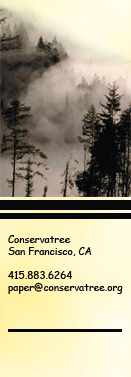


|
|||||||||||||||||||||||||||||||||||||||||||||||||||||||||||||||||||||||||||||||||
Company |
Printing & Stationery Paper |
EcoSource |
Hemp based printing paper |
Vision Paper is a leader in developing nonwood paper based on the use of kenaf fiber. Vision’s kenaf printing papers have been widely used for books, newsletters and other high profile printing.
Company |
Printing & Stationery Paper |
Vision Paper |
Kenaf fiber, Kenaf and Recycled content |
Green Field Paper in San Diego has been producing specialty papers for over a decade. Organic cotton, hemp and other fibers are incorporated into the papers produced by this artisan mill.
Paper Company |
Fiber |
Products |
Cotton, Hemp |
Stationery |
Costa Rica Natural produces papers and converted paper products such as notebooks that contain banana, coffee bean, citrus and other plant fibers. These specialty papers incorporate discards from agricultural harvesting and food production.
Paper Company |
Fiber |
Products |
Banana, Coffee Bean, Citrus, Tobacco |
Stationery |
The Text & Cover Mill Brands
A few of the major paper companies produce brands of paper with some tree free content. Some of the tree free papers are restricted to certain colors of a particular paper brand.
Currently, the tree free papers offered by major paper companies are produced by the higher-end text & cover paper mills and are suitable for stationery/letterhead and communication purposes such as brochures, invitations, advertising and such.
Paper Company |
Brand (color) |
Fiber |
Fox River Paper Co. |
Evergreen 50/50 |
Bamboo & Recycled |
Environment (colors: Tortilla, Mesa White) |
Bagasse & Recycled |
|
Bier Paper |
Beer mash & Beer bottle labels (60%), 40% Virgin tree fiber |
Cotton
Cotton fiber has long been used in papermaking and is considered a tree free fiber. Typically, cotton paper is used for expensive correspondence and stationery. Cotton is also used for specialty purpose paper, such as currency.
In fact, the term “bond” for writing grade paper comes from the understanding that people appreciated the quality of the cotton paper that securities, bonds and transaction documents were traditionally printed on, and therefore many people requested “that bond paper” when having stationery printed.
Some major producers of 100% cotton papers include the following companies.
Paper Company |
Stationery and Printing Paper |
100% Cotton, and Recycled Cotton Fabric |
|
Fox River Paper Co. (owned by Neenah Paper) |
100% Cotton, Cotton & Recycled paper blends |
Gilbert Paper (owned by Neenah Paper) |
100% Cotton, Cotton & Recycled paper blends |
Cotton & Recycled paper blends |
|
100% Cotton, Cotton & Recycled paper blends |
Office Paper
While most of the tree free papers we have seen on the market are high quality printing and stationery papers, there have been very few commodity style office copy/laser papers offered with alternative fibers.
But now there are beginning to be imported commercial office papers made with bagasse fiber (agricultural residue from sugar cane) available in North America, including from the Propal Paper mills in Columbia.
Paper Company |
Brand |
Fiber |
Propal |
TreeFrog |
100% Bagasse |
Distributed by www.treezero.com |
||
Newly Developed Tree Free Products
Developing tree free papers takes ingenuity and passion.
In addition to some of the above-mentioned leaders in tree free paper such as Vision Paper Co. and Living Tree Paper Co., Al Wong of Arbokem has been one of those rare people in the paper industry who has strived to change the paradigm that paper needs to be made from trees.
Currently, Arbokem is working to reintroduce its tree free paper production under the brand name Xativa. Status of printing paper production can be made via inquiry to Arbokem.
| Company | Fiber |
Hemp & Recycled content blend |
Artisan Paper Products
A new twist on recycling and tree free paper is being developed by a vintage/used clothing business.
Remains, Inc., based in St. Louis, MO, has launched Arch Paper, which is turning unsellable clothing into 100% postconsumer content cotton rag paper. While textile and fabric scraps have been used for paper production for years, paper mills such as Crane & Co use industrial textile scraps (and in come cases items such as linens from hotels and hospitals). But the approach by Remains, Inc., appears to be making paper out of by-products (used clothing) once they cannot make “higher and best use” of the material as second-hand, usable clothing. This truly is recycling and tree free paper.
| Company | Fiber |
Unsold second-hand clothing textiles |
Still More Directions
The quest to save trees and eliminate the use of forest fiber for paper production has reached further than just a return to the past. Paper was originally produced from plant fiber, the recovery and use of cotton and linen rags, as well as the recycling of old paper. But newer innovations in producing printable substrate in the past few years have been brought to our attention here at Conservatree. While these papers are not currently on our listing of environmental papers, we will discuss them here because the term “tree free paper” has been applied to these products.
Stone Paper
There are currently a few paper products that are made entirely of minerals with some binding agents and no cellulose fiber. Some of these products are marketed as “tree free” and many are generically stated to be made from “rocks” or “stone.” The truth is that these papers are made largely of minerals.
The use of minerals in paper production is nothing new. Most papers contain some amount of minerals such as calcium carbonate (marble). Coated papers (such as glossy magazine paper) contain large amounts of additives like calcium carbonate and kaolin (clay) coating, typically up to half the weight of the paper, in addition to the cellulose fiber.
In fact, the use of minerals in paper production has increased so much that, in addition to the concern among environmental organizations over timber and forest issues, paper companies and paper users are hearing from environmental groups organized around issues of mining and mineral resource depletion. A front page article in the Wall Street Journal in October of 2002 highlighted some of these issues.
Certainly the issue of sustainability comes into play when debating harvesting timber from the forest or mining minerals from the ground. Whether a particular paper is made entirely from minerals, the larger picture is that the entire paper industry is ever increasingly utilizing mineral additives in paper production.
The question we have to ask is, "Do we cut more trees or dig more earth or can we minimize both?" Quickly we come back to the issue of sustainability.
Here is information on (entirely) mineral based paper
Company |
Brand |
Products |
Tier1 International |
Photo / Digital paper |
|
Chameleon Packaging |
Converting / Printing |
|
XTerrane Limited |
Inkjet paper |
Plastics
A few years ago, the book Cradle to Cradle, by William McDonough and Michael Braungart, had an introduction chapter titled, “This Book Is Not A Tree.” Noticeable about the book, other than that it significantly weighs more than any similar 200-page book, is that the pages have a slick and indestructible quality. In fact, the cover says “water proof.”
The book says it is not made from wood pulp, but rather from “plastic resins and inorganic fillers.” The book discusses overall design for sustainability, including the recycling or, rather, the intentional reproduction of products, such as, in this case, a specific book back into another book.
When the book came out, Conservatree had a few inquires about the paper used for Cradle to Cradle. The material used is a version of a thermoplastic polymer film.
In theory, it can be recycled, much as a yogurt container can be recycled if it gets to somewhere that makes new material out of it, although currently there are few or no options.
A Conservatree staffer has a set of United States maps from National Geographic that he purchased in 1975 that are beautifully printed on similar polymer “paper.” The maps are extremely durable and waterproof! Polymer film papers are prefect for durable use items such as maps or printed matter such as a fishing guide, which might get wet.
One of the original uses of polymer film paper was in food packaging. This type of paper has been expanded to printing grade paper use for outdoor advertising, merchandise hang tags, medical products and, apparently, books intended for "bathtub reading.”
Yupo, a brand of polypropylene “paper,” is widely available from paper merchants in North America. Heavy-weight cover and translucent versions are some of the varieties offered. Special inks are required for printing.
| Company | Material |
Polypropylene (PP) |
Polyart, by Arjobex, is a brand of polyethylene "paper." Polyart is clay coated and works with inks used in standard commerical printing processes.
| Company | Material |
Polyethylene (PE) |
When exploring the issue of tree free paper and the environment, you may want to consider all the impacts. Similar issues are being explored when considering sustainable forestry and paper production. See: Which Environmental Characteristic Is Best.
Excrement
Here is the last word in tree free and recycled paper.
Several years ago we started hearing about paper made from reclaimed elephant dung. What is truly amazing is the number of manufacturers of elephant dung paper! Dung from India, Shi Lanka, Thailand and several locations in Africa.
Most of the dung papers are marketed with links to elephant conservation projects. Now there is talk about a panda conservation project attempting to jump onboard the poo-paper bandwagon.
Obviously this is a great novelty item. Positioned as "eco-paper," it is true that this is recycling of a waste product and deals with an issue that has at least been around since mammals emerged from the ocean.
There are just too many sources of elephant dung paper for us to list, so we just suggest you Google "elephant dung paper" to locate your favorite elephants.
Conservatree is a project of Social and Environmental Entrepreneurs (SEE).
Copyright 1988-2015 Conservatree
Terms of Use